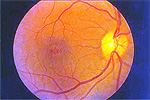| |
|
Macular Hole
Macular hole is a problem that affects
the very central portion of the retina. It happens for a variety of
reasons such as: eye injuries, certain diseases, and inflammation inside
the eye. However, the most common cause is related to the normal aging
process.
The vitreous gel inside the eye is firmly attached to
the macula. With age, the vitreous becomes thinner and separates from
the retina. Sometimes this creates traction on the macula, causing a
hole to form.
Macular holes often begin gradually and affect
central vision depending on the severity and extent of the problem.
Partial holes only affect part of the macular layers, causing wavy,
distorted, blurred vision. Patients with full-thickness macular holes
experience a complete loss of central vision.

SIGNS AND SYMPTOMS
The severity of the symptoms is dependent on whether the hole is partial
or full-thickness.
•Blurred central vision
•Distorted, "wavy"
vision
•Difficulty reading or performing tasks that require seeing
detail
•Gray area in central vision
•Central blind spot
DETECTION AND DIAGNOSIS
Visual acuity testing, Amsler grid, and
ophthalmoscopy are all performed to evaluate the macula's health and
function. The retina doctor may also order photographs of the macula
prior to performing surgery to repair the hole.
TREATMENT
Some
macular holes seal spontaneously and require no treatment. In many
cases, surgery is necessary to close the hole and restore useful vision.
Macular holes are repaired with surgery. During the operation,
the surgeon first gently removes the vitreous gel with a procedure
called vitrectomy. This eliminates any traction on the macula. A gas
bubble is injected in the eye to place gentle pressure on the macula and
help the hole to seal. In many cases, patients enjoy functional vision
after the bubble has dissipated and the eye has healed.
|
|